|
Main
Menu
External
Pages
|
Earth People
Magazine
Volume 2 Number
1
Now
Playing: 'Everything's Alright'
By: The
Dreamcatchers
Contact
Sitting Owl for a copy
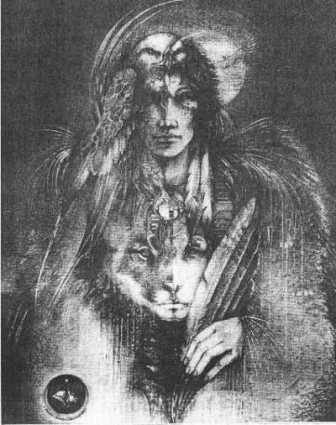
‘Rites of Passage’
By:
Susan Boulet
Printed from the front cover of
‘Teachings Around the Sacred Wheel – Finding the Soul of the Dreamtime’.
By Lynn V. Andrews.
Contents
Maori
Teachings
By:
Rangimarie (Rose) Turuki Pere
Becoming a Man
By: He Who Sees Through The Eyes And Wisdom Of The Eagle
Plenty Coups
Supplied
By: Margaret Bond
Jung’s Shamanic Journey
An Excerpt from: ‘Memories, Dreams, and Reflections’
By
C.G.Jung Compiled

 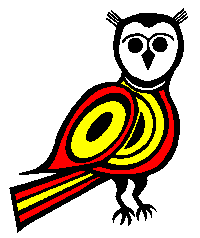
Donations
If you would like to make a donation to Sitting Owl
please use this button.
A Prayer for Harmony
By:
Frank 'Fools Crow' 1890 - 1989
Holy
Man and Medicine Man
Ceremonial Chief of the Teton Sioux
LAKOTA
- OGLALA TETON SIOUX
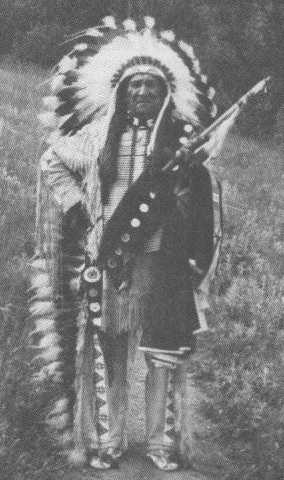
Wakan-Tanka, I thank you for our ancestors, for the life they have given each of us, and for the traditions they have preserved and handed down to us.
Wakan-Tanka, I thank you for my life and the opportunity to know you, to serve you and to serve our people. Continue to make me a responsible person and help me add to the good things you and my ancestors have given me.
Wakan-Tanka, I thank you for those who are yet to come and who will carry on from where we leave off. Help them to preserve the traditional life for the generation to come after them so as to keep the hoop turning.
Wakan-Tanka, I thank you for my brothers and sisters who are here to share this precious moment. I pray that you will bless them and always be with them.
Mitakuye Oyasin
Sitting Owl's Editorial
Report on the gathering at
Casuarina
I’m sorry that I didn’t get a chance to add this event in ‘Coming Events’, but as all things happen as they should, I’m sure that those who needed to be there, and were ready, were there.
The main purpose of this gathering was to find those who really do know and walk the absolute truth of the Great Spirit. It was an experience beyond words to see so many people who had endured the wait, to stand proud, in front of the elders and the Great Spirit, and firmly proclaim that they “accept the responsibility”.
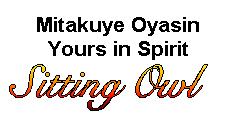 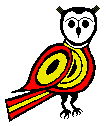
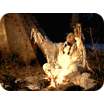 Shamanism
Shamanism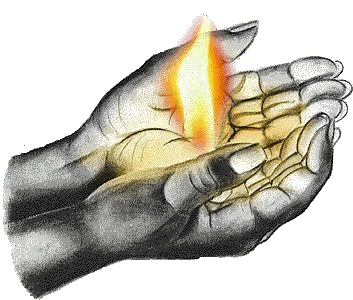

Firstly I would like to say that a shaman cannot be made, regardless of how much reading, teaching or knowledge one may do or acquire. They are chosen, whether or not they acknowledge it, like it, or understand it. However the basics of shamanism can be learnt by anyone wishing a greater understanding of life; in one way we are all shamans of our own lives. The life path of a shaman is difficult and full of responsibilities and sacrifices that are beyond description or comprehension, whether a title is used or not.
According to Professor Micea Eliade, the French historian who completed a cross-cultural study of shamanism, there is an overpowering mental crisis where one’s consciousness falls into the subconscious, in a type of schizophrenic crack up. This crack up is generally recognised as the main feature of the vocational summons; our hospitals and mental institutions are full of misunderstood and misunderstanding shamans.
Shamanism is a practice found in every part of the world and throughout all of history. However most cultures have their own term for the practitioner, for example, the Native Americans refer to them as medicine men and women or holy men and women, the Australian Aboriginals refer to clever men and women. The Hawaiian word for shaman is
Kupua, and they have been known as witches, wizards, sorcerers and wise men just to name a few. The word shaman is derived from the Tungusic language of Siberia and is now used as a convenient term to describe the practitioner and his or her practice.
Serge Kahili King Ph.D. in his book ‘Urban Shaman’ says:
“A lot of people have different ideas about what a shaman is and does, but like
Eliade, I tend toward a strict definition. Not every medicine man is a shaman, but a shaman might be a medicine man. Not every tribal priest is a shaman, but a shaman might be a tribal priest. Not every psychic healer is a shaman, but a shaman might be a psychic healer. For the purposes of this book and my teachings, I define a shaman as a healer of relationships: between mind and body, between people, between people and circumstances, between humans and nature, and between matter and spirit."
And regarding the two types of shaman, King says:
“A ‘warrior’ shaman tends to personify fear, illness, or disharmony and focus on the development of power, controls and combat skills in order to deal with them. An ‘adventurer’ shaman, by contrast tends to de-personify these conditions (i.e., treat them as effects, not things) and deal with them by developing skills of love, cooperation, and harmony.
“Shamanism, especially the Hawaiian variety, is well adapted to modern times and needs for several reasons:
1. It is completely non-sectarian and pragmatic. Shamanism is a craft, not a religion, and you practice it alone or with a group.
2. It is very easy to learn and apply, although, as with any craft, the full development of certain skills may take a while.
3. The Hawaiian version in particular may be practiced anywhere at any time, including at home, at work, at school, at
play, or while travelling. This is mainly because the Hawaiian shamans primarily worked with the mind and body alone. They did not use drums to induce altered states and they did not use masks to assume other forms or qualities.
4. The nature of shamanism is such that while you are healing others you are healing yourself, and while you are transforming the planet you are transforming yourself.”
Joan Halifax, in her book ‘Shaman – The Wounded Healer’ begins by saying:
“The life-way of the shaman is nearly as old as human consciousness itself, predating the earliest recorded civilisations by thousands of years. Through the ages the practice of shamanism has remained vital, adapting itself to the way of all the world’s cultures.
“Today the role of shaman takes many forms – healer, ceremonialist, judge, sacred politician, and artist, to name a few. The shaman lies at the very heart of some cultures, while living in the shadowy fringe of others. Nevertheless, a common thread seems to connect all shamans across the planet.
“An awakening to other orders of reality, the experience of ecstasy, and an opening up of visionary realms, form the essence of the shamanic mission… That this commonality cuts across seemingly irreconcilable ethnic and cultural line attests to the mystery and power lying at the source of myth, the human psyche.”
And from ‘Lynn Andrews in conversation with Michael Toms’, Lynn says:
“Shamanism is a way to create bridges between the everyday material or physical world and the world of spirit. Shamans have lived through a life-threatening situation and have come out the other side with special capabilities or a special vision of what our lives are all about. In contemporary life, there are millions of people who have done extensive work on them selves, and are shamans in their own right. They are people who have lived through disruptive family lives; people who were beaten up, either emotionally or physically; people who have learned to survive in an alien world and discovered realities invisible to most of us. When you look at the history of shamanism in ancient times, shamans were often people who had near-death experiences. Or faced madness, only to come out the other side with the ability to perceive realities other
than those most of us know, realities that some say exist in parallel to everyday existence.”
A true shaman is firstly and foremost an Earth Person, who lives the fundamental spiritual and natural way of giving sacred reverence and respect to all things all the
time; as all things are alive. Shamans are steadfast and honest, and they live morally and frugally, often giving up all pleasures and material possessions apart from what is absolutely necessary to practice their craft.
True shamans, medicine people, and holy people do not try to cheat or fool anyone to just get by. They work constantly, studying and perfecting their craft, and they don’t waste time or any other resources. But most importantly they keep their life in balance, between physical needs (Body), psychological needs (Mind), emotional needs (Vital and Heart), and spiritual needs (Soul).
According to Fools Crow, if you sincerely live this way you become a hollow bone for The Higher Powers (God etc.) to work in and through. He says that the cleanest bones serve
Wakan-Tanka and the helpers the best. And that medicine people and holy people work the hardest to become clean bones. And he says that the holy person is the one who becomes the cleanest of all.
The kinds of things that people clog their bones with are: fear, doubt, guilt, reluctance, desire, and selfishness just to name a few.
Regarding what makes a true shaman, medicine person or holy person Fools Crow says:
“You can tell a true medicine person from an imitator by what they ask you for in return for their help… [Imitators] may talk well, and they may have created ceremonies [and healing modalities] that will charm you, but these will not be ceremonies that are traditional and that come from the Higher Powers. Remember that evil can work ceremonies too. The strongest protection we have against evil is our pipe… When we have the pipe in our hands and use it in ceremony it is the same as it would be for a Christian if he could hold Jesus Christ in his hands while he prays.”
[This is supposedly what communion is all about. Ed.]
As some people may have realised, I don’t quite follow any particular tradition, although most of what I do is based on Native American traditions. As an Australian by birth, but not an Aboriginal, I do have a great respect for and understanding of their traditional ways, especially those that are documented by anthropologists in the early 1900s.
I am an adventurer shaman of the universal kind, giving respect and reverence to all life on, within, and around our Grandmother and Mother Earth. I listen, mostly through meditation of one kind or another, to my intuition, inner pilot, spirit guides, and all spirit around and within me (or whatever you call “The Force”). The messages I get do not come as voices or visions, but as an inner knowing, with an ecstatic ‘AHAH!’ feeling.
I began this path as a means to try to understand myself, not because it was trendy or to gain any power over anyone or anything. If I do have any power I now know that it is to be passed on to others and shared, as all power comes from The Great Spirit or God.
My knowledge of life comes mainly from my own experiences, which have led me to study all the cultures’ mythologies and religions of the world; and to understand the similarities between these, shamanism, and Carl Jung’s psychology. Jung actually put himself through a type of shamanic initiation so that he could observe all the different ways he could think and feel. And now he has given us all a better understanding of the human psyche, with all
its different levels, which is what the shamans call the many parallel worlds that exist at all times.
In some ways I create my own tradition by adapting the Northern Hemisphere’s traditions and teachings to suit the Southern Hemisphere. I do not do this to be disrespectful to those who have kept these traditions and passed them on, but as a way of helping myself and maybe others to understand life as it is experienced here, in the Southern Hemisphere.
For example, the medicine wheel is a traditional tool that has been used for millions of years in a myriad of forms and designs to give humans an understanding of life, so that they can bring harmony into their inner and outer life. This harmony comes from balancing the pairs of opposite energies like knowledge and emotions, spirit and matter, etc. So it doesn’t matter where around the wheel you place these as long as they are opposite each other. However, if the orientation of the medicine wheel also matches the energies of your outer environmental life of days, moons, and seasons etc., then bringing harmony to your inner and outer life can be achieved by understanding and living according to the one simple medicine wheel.
Sitting
Owl's
Medicine Wheel Ceremony
For
the southern hemisphere
As
adapted from the Lakota Wheel


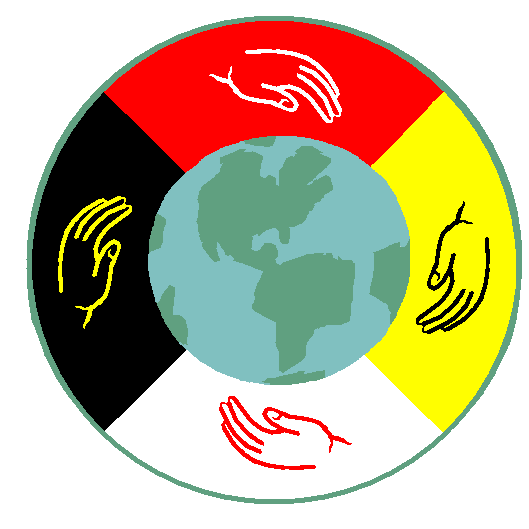
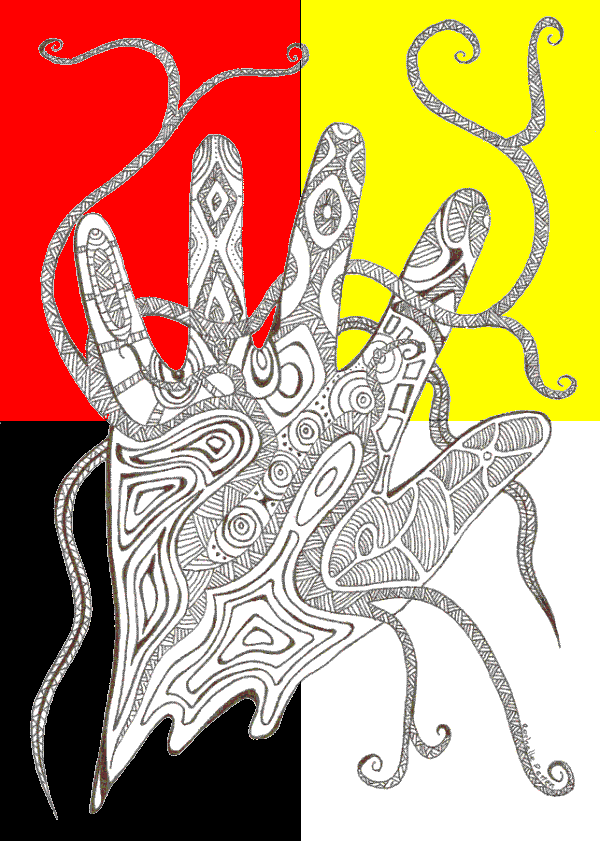
The
Medicine Wheel, among other uses and teachings, is symbolic of the four
ages of man and the changes of life’s energies.
Each transitional phase requires a death, or a letting go
of the old, and a rebirth, or opening up, to the new.
Everyone
is to face the direction as it is read out.
|
THE
EAST POWER
is known as
THE
FAR-SIGHTED PLACE.
|
The element for the East is FIRE and the colour association is yellow.
The East is is associated with HUMAN kingdom and it's enemy is Death.
The East is the
place of birth, birth of the SUN
every morning;
birth of the year every Spring
and the
place of un-manifest Spirit, Childhood, and the
human experience of Spirit. As children fresh from the spirit world, we are as
far-sighted as the EAGLE
who symbolizes illumination and enlightenment. The child is a being of pure spirit,
searching, soaking up, and trying to learn to have a physical body.
|
THE NORTH POWER
is known as
THE
CLOSE-TO PLACE.
|
The
element for the North is WATER and
the colour association is red.
The North is is associated with PLANT kingdom and it's enemy is Fear.
The North is the place of growth, as the midday
and Summer sun creates
maximum growth. This is the place of the Lover
and Warrior, where in our Childhood
and Adolescence
our environmental emotions
and strengths are being learnt and tested in a trusting and innocent
spirit, and we see and scrutinise the detail like the MOUSE,
who symbolises this power. The physical-ness of our being grows to its
zenith, a man as a warrior and a woman as a lover. This is where the
cycles of the MOON
are of great influence and we need to understand the fluidity of life.
|
THE WEST POWER
is
known as
THE LOOKS WITH-IN PLACE.
|
The
element for the West is EARTH
and the colour
black is its association. The West is is associated with
MINERAL kingdom and it's enemy is Powerlessness.
The West is the place of Middle-age, the place of change and
introspection, of going with-in to find the inner strengths of our own
spirit, like the BEAR
who hibernates in the ‘Dream Lodge’ and is the symbol of the healing
energy of this power. This
is the Autumn
and evening
time of our life, when light (Physical body) fades and darkness (The dark night of the soul) emerges. We
change from being the fullest physical warrior
and becoming a spiritual lover;
or changing from a physical lover
into a spiritual warrior. This is
the place of the maturing adult and becoming a grounded being of
EARTH.
|
THE
SOUTH POWER is known as
THE PLACE OF KNOWLEDGE and WISDOM. |
The element for the South is AIR and the associated colour is white.
The South is is associated with ANIMAL kingdom and it's enemy is Certainty.
The South is the place of the knowledge and wisdom of the
Elderly,
and with the vast wisdom of the STARS. The white hair arrives on our head like
the cold Winter
winds that bring the snow, and keep our mind
in full awareness of Spirit and matter. Our potential is to be the
King or Magician in the place of honour and respect as the BUFFALO or
KANGAROO, who are the animal masters of the
Native American people or Aboriginals, because they are the ones that
give their lives so that we may live. This is the time when the darkness
of midnight
and death is illuminated by Spirit.
 
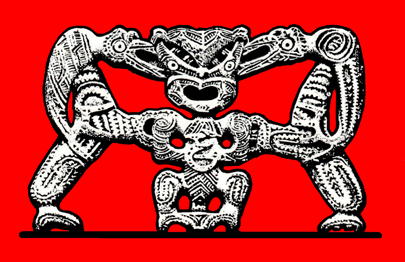
Maori Teachings
By: Dr. Rangimarie
(Rose) Turuki Pere
Wairua
– Spiritual dimension
A powerful belief in spirituality governs and influences the way
one interacts with other people and relates to her or his
environment. The natural place of worship/communion with AIO Matuua,
God/Goddess, the Divine Parents, and Rehua (Christ).
Tutira mai nga iwi tatau tatau e
Whaia te maramatange me te aroha
E nga iwiw ki a tapatahi tatau tatau e
Assemble and join forth all peoples (of the world).
Pursue enlightenment and uphold the presence and breath (of the
Great Spirit)… unconditional love.
All peoples unite and move forward together.
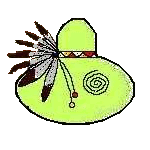 Illumination Illumination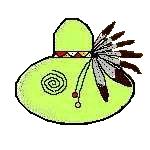
By: Lynn
V. Andrews
As darkness comes, the mirrors of your spirit reflect different images. It is the time when the world changes and your being begins to glow. Reflect on the new vision that has been living on the perimeter of your consciousness. An idea is stalking you and awaits your invitation, a place within you to begin life. The totality of your creativity comes after you have begun your work on the sacred painting of your life. It is then that the muses of inspiration surround you like eagles and cheer you on to illumination. Take responsibility for your work and your life, and then illumination will follow.
The eagle of the east is the messenger from the earthly spirit to the Great Spirit.
Copied with permission
from:
‘The Power Deck’
 Branches
Branches

of the God Tree
By: Sri Chinmoy
One can practice spirituality irrespective of which religion one belongs to…
A true spiritual seeker will have the deepest respect and utmost reverence for all religions. We can treasure all religions and claim them as our very own. Each religion is like the branch of the God-tree. How can we deny the value of the branches when we accept the tree as our very own? Each religion is right, absolutely right, in its own way, but when we cry for the highest Truth, love of God becomes our only religion.
True spirituality will not demand the renunciation of any religion. If you remain in your own religion and practice the spiritual life, you will be able to run very fast toward the goal. Your own religion will give you constant confidence in what you are doing. Again, you may feel the need to transcend religion. In either case, your goal is to realise God, who embodies all religions and, at the same time, is far above [and beyond] them.
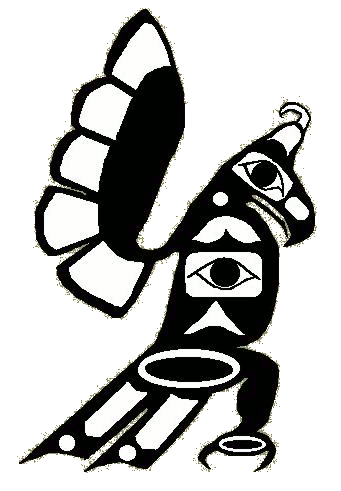 Becoming A Man Becoming A Man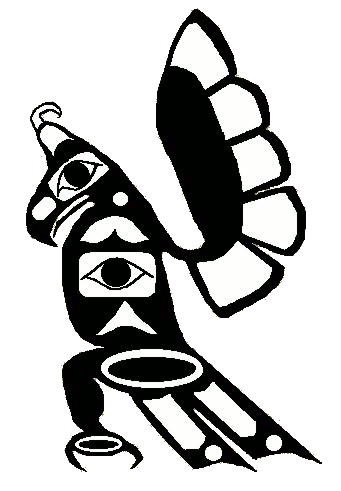
By: He Who Sees Through The
Eye And Wisdom Of The Eagle
[My Grandfather and I] talked many times about becoming a man. Indian boys think of nothing else most of the time. They are in a hurry to prove that they are men, I was no different.
The first time my Grandfather and I discussed this, he told me that most boys must take a feather from an eagle without harming it, and that would make them a man. So, naturally I was busy trying to figure out how I would do this and become a man as soon as possible. Soon I had a plan, and set about trying my luck.
I built a small hatch out of branches that I could sit in with branches for a roof, and I covered it all with leaves and twigs. I had been raising rabbits and pigeons for some time, so I decided to start feeding the eagle. Each day I would take a rabbit or a pigeon out to my hatch and tie the poor thing on to the roof of my hatch. I watched for many days with no luck, but then, down out of the sky the eagle swooped and landed on my rabbit. It sat there for about an hour enjoying its meal, I was totally excited that my plan had worked. So, then each day after that I would take my poor rabbit or pigeon to the hatch and the eagle would arrive for its feast.
Soon I began to sit under the hatch and watch the eagle while it ate its meal. After a few days of watching, I finally built up the courage to have a try at grabbing the eagle. The eagle was sitting there enjoying its meal and I reached up and grabbed its two legs. As you can imagine the eagle was not very pleased about its situation. Then with both hands full, I pushed my head up through the branches and bit into the eagle's tail feathers, and pulled with all my strength to remove the feathers. At this stage the eagle started pecking at my hands, and I still carry the scars to this day from the damage the eagle inflicted upon me. But after letting go, he flew off and I had four beautiful eagle feathers in my mouth.
I ran all the way to my Grandfathers house to show him that I had indeed become a man. I was eight years old at the time, and my Grandfather was very pleased with my success and amazed that I had been able to get four feathers from the great eagle without harming it. He then started fixing the cuts covering my hands.
As he cleaned the blood from my hands he reminded me that he had said that most young men had to gather an eagle feather to become a man, but he said that that didn’t include me. Because I was a special person, it would require a special task for me to become a man. I was very hurt to find out that I had not succeeded in becoming a man after all that hard work, and the injuries I had sustained.
At that point, still in a hurry to become a man, I asked my Grandfather what special task I would have to perform to become a man. He said it would have to be very difficult because I had done the normal manhood task so easily. I was thinking at the time that the many weeks of hard work and waiting should have been enough, but I said nothing. He then told me that my task might be something like killing a deer with only my knife, so that my wilderness skills would improve. I was already thinking how I would perform this new task, and in just a few minutes had figured out what I would do when my Grandfather shocked me by saying; “And no, you can’t jump out of a tree on top of the deer.” Which is exactly what I was thinking.
Many times throughout my life my Grandfather was able to read my mind or show up just when I needed him the most. He would simply say; “I heard you, so I’m here.” He saved me from myself throughout my life. If I were doing the wrong thing he would arrive and tell me to change my ways. Even when I was at University, he would turn up and tell me to change the road I was on, so that I may become a "real person". He was always right, and he helped me to come down to earth and realise that the only true road to travel is the humble road.
Finally, at the age of fourteen I did become a man. After many weeks of stalking deer with only my knife, I learned to become part of the bush. I was covered from head to toe with branches, and I rubbed myself all over with the mulch from the forest to mask my smell. I prayed each day to the Great Spirit to help me to finish my task. But success didn’t come until I remembered one of the lessons my Grandfather had taught me as a young boy.
One morning I prayed to the Great Spirit as usual, then I prayed to the spirit of the deer, asking the deer to give its permission for me to become a man. As I asked the deer to give itself to me, I told it that its sacrifice would stay with me for the rest of my days. I promised that I would use every part and not waste anything, using the stomach and bones in my mother’s garden, so that his sacrifice would improve the land on which we walk. I promised to use his antlers for beautiful buttons and necklaces for my family, and I promised to use all the meat and share it with as many people as I could. I then wished the deer a good journey, and I promised to join up with him in the next life where I would feed him and look after him as a friend.
After smudging myself with the smoke from my fire to make myself pure, I set out for another try. I had only gone a short way when, to my surprise, a beautiful buck was standing in the trees feeding. I froze where I stood, and shortly the buck started walking toward me. He must have thought I was a bush, because he walked within a couple of feet of me, so I struck out at him with my knife. I had been able to stab the deer in the neck, and with a quick turn and slice, I had cut the animal’s throat.
The deer suffered very little, and quickly died in my arms comfortably and without any thrashing about. He had willingly given himself to me and died with a look of peace in his eyes that I will never forget. And as all Indians do, I took his last breath in my mouth to take the spirit of the deer with me for life.
I cleaned the animal and ate a small strip of the liver, as is the custom. I carried every part of the deer home and kept my promises to the deer. I crushed its bones and placed them in my mother’s garden. I made buttons and necklaces for members of my family, and I made jerky from the meat, which I shared with everyone.
I am not ashamed to admit that I cried for the deer and his sacrifice in the forest that day. I had tried unsuccessfully for three weeks camping in the forest, and it wasn’t until I showed reverence to the animal, that it gave itself to me. Showing me that the true meaning of becoming a man is not just being strong and brave, but to show true reverence, love, and care for all God’s creatures and this beautiful earth that he gave us all to live upon.
Go in peace
He Who Sees Through the Eyes and Wisdom of the Eagle
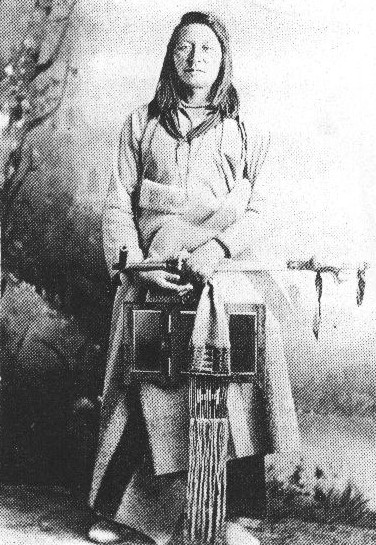
.jpg)
Courtesy of
the Smithsonian
Institute
Photo By: Edward
Curtis Portrait (c1908)
Plenty Coups 1848-1932
Supplied By: Margaret Bond
Plenty Coups or
Aleek-chea-ahoosh, meaning "Many Achievements”, was a noted Mountain Crow warrior who never fought against the white man. Plenty coups was born in the Crazy Mountains near Billings, Montana in the summer of 1848. He was the son of Otter Woman, a Crow, and Medicine Bird, a part Shoshone warrior. He received the name Aleek-chea-ahoosh from his grandfather who said “I have dreamed that he will live to count many coups and be old; my dream also told me that he will be a chief – a great chief our people will ever have.” In his youth, he achieving 80 feats of valour in combat, he also had boyhood names of Faces the buffalo North and Swift Arrow. His war exploits were such that he became a chief when he was about 25 years old.
In 1876 Plenty Coups was the leader of General Crook’s Indian Scouts during the campaigns against the Sioux. Some say Plenty Coups was responsible for, the successful negotiations with the Northern Pacific Railroad in gaining the right to construct the line through the Crow territory; the payment made to the Crow was larger than the settlement usually made in such transactions. In 1883 Plenty Coups led the delegation conferring with the
Davies Commission, and shortly thereafter went to Washington, D.C., to strengthen the Crow claims for land payments. Plenty Coups became one of the first of his tribe to take up farming and ranching by which he grew prosperous, and by 1890 he was regarded as one of the most respected Crow leaders.
In 1904, when Pretty Eagle died, Plenty Coups became the principal Chief of all the Mountain Crow people. Despite occasional friction, Plenty Coups held the Whites in high esteem, and during World War 1 he urged his young men to join the U.S. Armed forces.
Later Plenty Coups was chosen to be the Indian representative at the tomb of the Unknown Soldier at Arlington, Virginia on November 11, 1921. Plenty Coups was reputed to have had 11 wives, among them were Magpie, Strikes the Iron, and Kills Together, but he had no children. On March 4, 1928, Plenty Coups and his wife willed their home and 200 acres to the United States as ”a memorial to the Crow Nation”, to serve as a reminder of friendship between the Indians and the Whites. Today it is maintained as a museum of Crow culture and history.
Plenty Coups died at Pryor, Montana on May 3, 1932. As an indication of Crow regard for Plenty Coups, it was decided that after his death, there would be no more Crow "Chiefs".
The following is an extract from his autobiography which is found in ‘Touch the Earth – A Self-Portrait of Indian Existence’ Compiled by
T.C. McLuhan:
"By the time I was forty, I could see our country was changing fast, and that these changes were causing us to live differently. Anybody could now see that soon there would be no buffalo on the plains and everybody was wondering how we could live after they were gone. There were few war parties, and almost no raids… White men with their spotted-buffalo [cattle] were on the plains about us. Their houses were near the water-holes, and their villages on the rivers. We made up our minds to be friendly with them, in spite of all the changes they were bringing. But we found this difficult, because the white men too often promised to do one thing and then when they acted at all, did another."
"They spoke very loudly when they said their laws were made for everybody; but we soon learned that although they expected us to keep them, they thought nothing of breaking them themselves. They told us not to drink whisky, yet they made it themselves and traded it to us for furs and robes until both were nearly gone. Their Wise Ones said we might have their religion, but when we tried to understand it we found that there were too many kinds of religion among white men for us to understand, and that scarcely any two white men agreed which was the right one to learn. This bothered us a good deal until we saw that the white man did not take his religion any more seriously than he did his laws, and that he kept both of them just behind him, like Helpers, to use when they might do him good in his dealings with strangers. These were not our ways. We kept the laws we made and lived our religion. We have never been able to understand the white man, who fools nobody but himself."
And in 1909 in an address at the Little Bighorn council grounds he said:
"The ground on which we stand is sacred ground. It is the dust and blood of our ancestors. On these plains the Great White Father at Washington sent his soldiers armed with long knives and rifles to slay the Indian. Many of them sleep on yonder hill where Pahaska – White Chief of the Long Hair [General Custer] – so bravely fought and fell. A few more passing suns will see us here no more, and our dust and bones will mingle with these same prairies. I see as in a vision the dying spark of our council fires, the ashes cold and white. I see no longer the curling smoke rising from our lodge poles. I hear no longer the songs of the women as they prepare the meal. The antelope have gone; the buffalo
wallows are empty. Only the wail of the coyote is heard. The white man’s medicine is stronger than ours; his iron horse rushes over the buffalo trail. He talks to us through his ‘whispering spirit’ [the telephone]. We are like birds with a broken wing. My heart is cold within me. My eyes are growing dim – and I am old…"
See also the wikipedia page: http://en.wikipedia.org/wiki/Plenty_Coups
Editors note on Counting Coup, thanks to some information from ‘He Who Sees Through the Eyes and Wisdom of the Eagle’:
Counting Coup was originally a game of war, where they would swing their axe at the opposition, but at last second they would turn their axe so as to hit with the flat side of the axe and only thump them on the chest. This is called a coup and if it were a real war the opponent would be dead. But by doing this in real war, it showed how brave a warrior was. At the end of a game both sides would count the coup to decide who had won.
See also the wikipedia page: http://en.wikipedia.org/wiki/Counting_coup
Jung’s Shamanic Journey
into the Psyche
Excerpts
from ‘Memories, Dreams, Reflections’
By: C. G. Jung
Compiled and Entitled

[Seeking, from page 162]
I have frequently seen people become neurotic when they content themselves with inadequate or wrong answers to the questions of life. They seek position, marriage, reputation, outward success or money, and remain unhappy and neurotic even when they have attained what they were seeking. Such people are usually confined within too narrow a spiritual horizon. Their life has not sufficient content, sufficient meaning. If they are enabled to develop into more spacious personalities, the neurosis generally disappears. For that reason the idea of development was always of the highest importance to me.
[The spirit journey through the tunnel, from page 205]
In order to seize hold of the fantasies, I frequently imagined a steep descent. I even made several attempts to get to the very bottom. The first time I reached, as it were, a depth of about a thousand feet; the next time I found myself at the edge of a cosmic abyss. It was like a voyage to the moon, or a descent into empty space. First came the image of a crater, and I had the feeling that I was in the land of the dead. The atmosphere was that of the other world.
[Mythology, from page 153]
Since the essence of psychotherapy is not the application of a method, psychiatric study alone does not suffice. I myself had to work for a very long time before I possessed the equipment for psychotherapy. As early as 1909 I realised that I could not treat latent psychosis if I did not understand their symbolism. It was then that I began to study Mythology.
[Mythology, from page 213]
It is, of course, ironic that I, a psychiatrist, should at almost every step of my experiment have run into the same psychic material which is the stuff of psychosis and found in the insane. This is the fund of unconscious images which fatally confuse the mental patient. But it is also the matrix of a mythopoeic
[mythological Ed.] imagination which has vanished from our rational age. Though such imagination is present everywhere, it is both tabooed and dreaded, so that it even appears to be a risky experiment or a questionable adventure to entrust oneself to the uncertain path that leads into the depths of the unconscious.
[Personifying God and all images of the
unconscious, from page 211]
The essential thing is to differentiate oneself from these unconscious contents by personifying them, and at the same time to bring them into relationship with consciousness. That is the technique for stripping them of their power. It is not too difficult to personify them, as they always possess a certain degree of autonomy, and separate identity of their own. Their autonomy is a most uncomfortable thing to reconcile oneself to, and yet the very fact that the unconscious presents itself in that way gives us the best means of handling it.
[The science of the psyche, from pages 217 & 218]
When I look back upon it all today and consider what happened to me during the period of my work on the fantasies, it seems as though a message had come to me with overwhelming force. There were things in the images which concerned not only myself but many others also. It was then that I ceased to belong to myself alone, ceased to have the right to do so. The knowledge I was concerned with, or was seeking, still could not be found in the science of those days. I myself had to undergo the original experience in the soil of reality; otherwise they would have remained subjective assumptions without validity. It was then that I dedicated myself to service of the psyche. I loved it and hated it, but it was my greatest wealth. My delivering myself over to it, as it were, was the only way by which I could endure my existence and live it as fully as possible.
Today I can say that I have never lost touch with my initial experiences. All my works, all my creative activity, has come from those initial fantasies and dreams which began in 1912, almost fifty years ago. Everything that I accomplished in later life was already contained in them, although at first only in the form of emotions and images.
My science was the only way I had of extricating myself from that chaos. Otherwise the material would have trapped me in its thicket, strangled me like jungle creepers. I took great care to try to understand every single image, every item of my psyche inventory, and to classify them scientifically – so far as this was possible – and, above all, to realise them in actual life. That is what we usually neglect to do. We allow the images to rise up, and maybe we wonder about them, but that is all. We do not take the trouble to understand them, let alone draw ethical conclusions from them. This stopping-short conjures up the negative effects of the unconscious.
[Shaman the wounded healer, from page 242]
And just as the wounder wounds himself, so the healer heals himself. Significantly, in the dream the decisive activity is carried out by the dead upon the dead, in the world beyond consciousness, that is, in the unconscious.
[Integration and revelation, from page 317]
What happens within oneself when one integrates previously unconscious contents with the consciousness is something which can scarcely be described in words. It can only be experienced. It is a subjective affair quite beyond discussion; we have a particular feeling about ourselves, about the way we are, and that is a fact which it is neither possible nor meaningful to doubt. Similarly, we convey a particular feeling to others, and that too is a fact that cannot be doubted. So far as we know, there is no higher authority which could eliminate the probable discrepancies between all these impressions and opinions. Whether a change has taken place as the result of integration, and what the nature of that change is, remains a matter of subjective conviction. To be sure, it is not a fact which can be scientifically verified and therefore finds no place in an official view of the world.
[Truth, duality and quantum physics, from pages 177 & 178]
The pendulum of the mind oscillates between sense and nonsense, not between right and wrong. The numinosum
[numinous – the feeling of attraction and awe characteristic of man’s sense of communion with God and
religion. Ed.] is dangerous because it lures men to extremes, so that the modest truth is regarded as The truth and a minor mistake is equated with fatal error… Yesterday’s truth is today’s deception, and yesterday’s false inference maybe tomorrows revelation. This is particularly so in psychological matters, of which, if truth were told, we still know very little. We are still a long way from understanding what it signifies that nothing has any existence unless some small – and oh, so transitory – consciousness has become aware of it.
[From page 329]
I have also realised that one must accept the thoughts that go on within oneself of their own accord as part of one’s reality. The categories of true and false are, of course, always present, but because they are not binding they take second place. The presents of thoughts is more important than our subjective judgement of them. But neither must these judgements be suppressed, for they also are existent thoughts which are part of our wholeness.
 
 Preface to: Preface to: 
'Teaching Around the Sacred Wheel'
By: Lynn
V. Andrews
I am a woman of the twentieth century a white woman living in an urban setting and in an era which we have lost our traditions, our ceremonies, our rituals. In losing touch with these ancient circles of mystery, which were once the gateways to uncommon dimensions of reality, we have lost touch with the wilderness of our own spirit.
I write at a time of hope, however. Many of us are reaching out, looking for alternative ways to understand the rhythms of Mother Earth, to worship God or the Goddess, and to balance the male and female energies within ourselves and on the planet. We have come full circle in our quest, and the ancient concepts of shamanism, the sacred Dreamtime, and the sacred wheel of shamanic teaching are now alive and fresh again. We have been able to move around the wheel from shamanism through science and back again to the beginnings, to our origins. We can again realise that we are nothing without the Great Spirit, the Creator; we are nothing without our magnificent Mother Earth, who gave us life. We are made from the stars and to the stars we must return.
Throughout my journey, I have been blessed with extraordinary teachers, native teachers, women who have taught me the ancient and sacred way of woman. My teachers, who are called the Sisterhood of the Shields, have taught me that three hundred thousand years ago, the star nations came down to Mother Earth from the Pleiades, and they invested great knowledge in our planet. This knowledge was planted, like seeds, in the oceans, the trees, and the mountains, and this wisdom has been uncovered at various times throughout our history when, but only when, our societies have been ready to hear it.
Much of what was told was memorised by certain women who represented the indigenous cultures of the world. These few women transmitted this wisdom, through the oral tradition, to their daughters and apprentices throughout time until now.
Teachings Around the Sacred Wheel describes some of what I have learned and have been asked to teach by the Sisterhood in my own process of evolving. When I was in
Nepal and Tibet, I prepared with the Sisterhood, and then with the help of my research at home in Los Angeles, a series of trainings to be given at certain times. This workbook is the result of that process.
The work here is designed to help beginning shamans exercise their intent, their shaman will, their ability to visualise and manifest on different levels of consciousness. Every word and sound is chosen carefully to produce an elevating effect within the person using the book. The book is not devoted exclusively to traditional Native American tribal techniques; it incorporates the shamanic teachings of the Sisterhood of the Shields.
We in the Sisterhood are shamans, but we are not affiliated with any tribe. The teachings that we pass along originated three hundred thousand years ago, but we are of this time and of this soil, and I have learned that we must make peace with the spirits of the land. It has been shown to me that no one owns the truth, that we, as children of Mother Earth, must reach hands across cultural boundaries and heal our Great Mother.
Whether we live in the great cities of the world or in the wilderness, all of us, through the sacred teachings, can learn to reconnect with our origins.
Wishing you peace and joy along your path of heart
Copied with permission
from:
'Teaching Around the Sacred Wheel'
The Different Levels of Vibration
and Manifestation

Inspired By: Sri Chinmoy
Body - The Body is the heaviest vibration and therefore is the physical life of matter. It can be either idle
(undivine) or energetic (not restless – divine).
Vital - The Vital makes up many of the emotions and unconscious reactions, and is very much where our desires come from. The undivine aspect is hostile aggression, and the divine quality is dynamism and wakefulness.
Mind - The Mind contains our mental or conscious thoughts and some emotions. The PHYSICAL mind is infinitely afraid of the infinite vast; it houses the ego; and it fears, doubts, and is jealous of everything. The SPIRITUAL mind stays in the aspiring heart and sees the higher truth.
Heart - The Heart is the receiver and sender of love, divine light, and joy. It is never limited. The heart simplifies, the mind complicates. It is all love, all sympathy, all concern, all purity, all harmony, and all oneness.
Soul - The Soul is the highest vibration and is therefore all light and all divine. It is the transcendent self, the God self, or Inner Pilot.
Prayer is speaking to God, Supreme, Great Spirit, or any name you prefer.
Meditation is listening to God etc.
 
The Black Door
Unknown source
Several generations ago during the most turbulent of the desert wars in the Middle East, a spy was captured and sentenced to death by a general of the Persian Army. The general, a man in intelligence and compassion, had adopted a strange and unusual custom in such cases.
He permitted the condemned person to make a choice. The prisoner could either face the firing squad or pass through the Black Door.
As the moment of execution drew near, the general ordered the spy to be brought before him for a short, final interview, the primary purpose of which was to receive the answer of the doomed man to the query, ”What shall it be… the firing squad or the Black Door?”
This was not an easy decision and the prisoner hesitated, but soon made it known that he much preferred the firing squad to the unknown horrors that might wait for him behind the ominous and mysterious door. Not long thereafter, a volley of shots in the courtyard announced that the grim sentence had been fulfilled.
The general, staring at his boots, turned to his aide and said, “You see how it is with men, they will always prefer the known way to the unknown. It is characteristic of people to be afraid of the undefined. Yet I gave him his choice.”
“What lies beyond the Black Door?’ asked the aide. “Freedom”, replied the general. “And I have known only a few men brave enough to take it.”
 
I am also
available 24 Hrs For:
Life and Energy Counselling.
Dream and Vision Interpretations.
Shaman Stone and Medicine Card Readings.
Shamanic Studies.
Mythology Studies.
Spirit Journeys.
Vision Quests.
Stone-people (Sweat) Lodges.
Meditation.
Chakras and Auras.
Healing the Healer.
Understanding Vibration, Manifestation and Quantum Physics.
All manner of spiritual cleansing, making sacred space, and sacred
ceremonies.
 
Donations
If you would like to make a donation to Sitting Owl
please use this button.
|